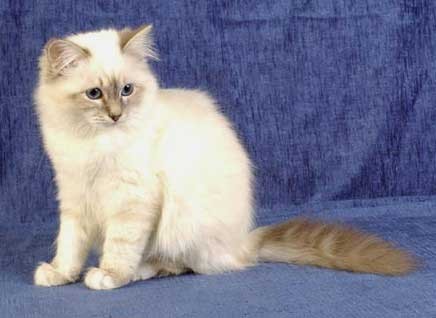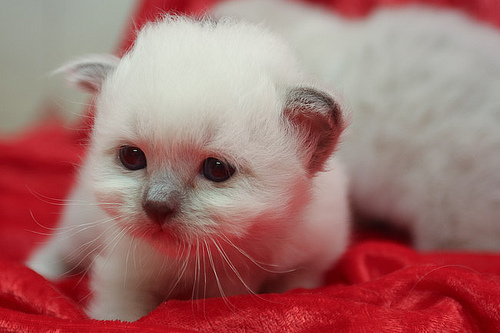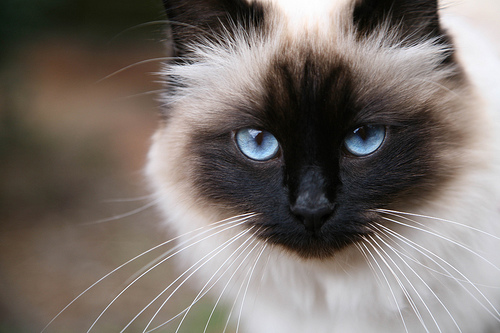



|
Birman Description
The Birman is a long, stocky cat with a silky coat that is easy to maintain, as it does not easily mat. The cat has nearly rounded eyes set in a strong face and should have ears twice as wide as they are tall; the bluer the eyes the better.
The coat of the Birman should appear as though it is covered in a golden mist. The Birman is a pointed cat, following in the Persian or Siamese tradition, and comes in four point colors: seal, blue, chocolate, and lilac. There should be a strong contrast between coat and point color. Points, minus gloves, should be the same shade with the mask covering the entire face. There are three color classes divided by pointing style as only the four point colors are acceptable.
Gloves are the most challenging part of the cat to breed as symmetrical pairs are ideal and nearly impossible to achieve. The gloves on the front paws should end in an even line across the paw, no higher than the third joint. Back gloves should cover all toes and may extend higher. Pads should be pink, through spotting is acceptable. It is interesting to note that all Birman's are born a solid white and develop their colors over time.
Birman Temperament
The Birman has what can be called a "middle of the road" personality. They adore attention but are perfectly happy to go without it until they want it. They are very soft-voiced until they are ready to be worshiped, and the demand may be accompanied by a frustrated N-O-O-O-OW sound. Once they've received what they feel to be appropriate adoration, the Birman will let you be until they decide they've been neglected and want your attention once again.
Birmans are social animals and easily become lonely in a single pet home. It is best to provide them with a companion animal. They are not stuffy, and are happy to be accompanied by anything from another Birman to the family dog.
Birman Care
Though the Birman does have a long-haired coat, the fur does not mat. Care for the Birman is simple, and though they appreciate a brushing it is not necessary.
Birman History
The history of the Birman must always begin with the legend of how the breed received its distinctive coloring and gloved paws.
In a temple on Mount Lugh lived the Kittah Mun-Ha. His life was dedicated to the adoration, contemplation, and holy service of Tsun Kyan-Kse, the Goddess with the sapphire eyes. Always near him as he lived in meditation was Sinh, an all-white cat whose eyes were yellow from the reflection of the Goddess with the heavenly eyes. Sinh's ears, nose, tail, and extremities of his legs were dark like the color of the earth.
One night raiders attacked the temple and Mun-Ha was mortally wounded. At the moment of the Mun-Ha's death, Sinh placed his feet on his master, and faced the goddess. A miraculous transformation took place; Sinh's white fur took on a golden glow, reflecting the golden goddess. His eyes became as blue as hers. His face, ears, legs and tail remained the brown of the earth, but his four paws, touching his beloved master, became pure white - a symbol of purity. The other priests watched the transformation in awe and were inspired to fend off the attackers.
Seven days later, Sinh died, taking the soul of Mun-Ha to paradise. On that day the priests consulted before the statue to decide on Mun-Ha's successor, when all the cats of the temple ran up. All were dressed in gold with white gloves and had eyes changed from yellow to sapphire. In complete silence they surrounded the youngest of the Kittahs making the goddess' decision known. The legend states that each Sacred Cat carries the soul of a priest on its final journey to paradise.
The modern history of the Birman is far less romantic. There are two stories behind the revelation of the Birman in the western world. The first is that a mated pair of Birman's were purchased by a wealthy tourist named Mr. Vanderbilt from a disgruntled temple servant. Mr. Vanderbilt then proceeded to send the cats off to a friend in France. The other story is that the mated pair was sent to a couple of Englishmen residing in France by grateful priests whom they had helped to defend their temple. Regardless of how the cats were sent to France, it is known that the male name Madalpour died enroute and only the female, Sita, survived. Thankfully she was pregnant and the first western litter of Birmans was born.
The breed was popular, but by the end of WWII it is believed that only one breeding pair was still alive. This forced breeders to outbreed in order for the Birman to survive, which it did with great success. The Birman received Championship status in England in 1966 and in America with the CFA in 1967.
|